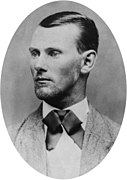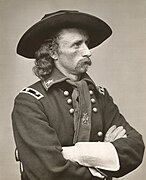The Wild West - The Real Story
| Television series | |
|---|---|
| German title | The Wild West - The Real Story |
| Original title | The American West |
| Country of production | United States |
| original language | English |
| year | 2016 |
| Production company |
SundanceTV / AMC Studios |
| length | about 45 minutes |
| Episodes | 8 in 1 season |
| genre | Docu-drama |
| Director |
John Ealer , Johnny Saint-Ours |
| production | Robert Redford |
| First broadcast | June 11, 2016 (USA) on AMC |
First publication in German |
June 4, 2018 on Netflix |
The Wild West - The True Story (Original title: The American West; working title: The West) is an eight-part docu - miniseries which the development of the American West has about 1865 to 1890. Executive producer was actor and Sundance Production co- founder Robert Redford . The series, consisting largely of game scenes, was distributed by Sundance Production and AMC , first broadcast by AMC in June and July 2016, and has been included in the Netflix streaming service since June 2018 .
content
The series focuses on the development of the Wild West in the decades between the Civil War and the beginning of the 20th century . The storyline is structured chronologically - with the fate of well-known protagonists forming the narrative red thread: Jesse James , General George Armstrong Custer , the Sioux leaders Sitting Bull and Crazy Horse , Billy the Kid and Wyatt Earp . The series also portrays the US Presidents Ulysses S. Grant and Rutherford B. Hayes , the detective agency founder Allan Pinkerton and the military commander-in-chief William T. Sherman as other important figures in contemporary history . Other people who are portrayed in supporting roles are companions like Cole Younger , Thomas C. Durant , Pat Garrett , Buffalo Bill and Doc Holliday .
The plot of the individual episodes offers a mix of partly opulently staged game scenes and commentary interview sequences. In addition to Robert Redford as executive producer, actors from recent Western productions such as Kiefer Sutherland , Tom Selleck and Ed Harris explain the events depicted. In addition, there are statements from relevant historians and non-fiction authors such as Walter R. Borneman, HW Brands , Anne Collier, David Eisenbach, Eric Foner , Mark Lee Gardner, Ann Kirschner and the Lakota activist Larry T. Pourier. Former Republican presidential candidate John McCain and Bill Richardson , former governor of the US state of New Mexico, also provide assessments of the history of the American West .
The total of eight episodes work their way through the epoch described in chronological form. American Divited (episode 1) describes the situation after the civil war with a focus on reconstruction policy towards the defeated southern states and land reclamation in the previously undeveloped prairie areas in the west. Episodes 2 (Two Front War) to 4 (Showdown) follow the threads of the four protagonists Jesse James on one side and George A. Custer, Sitting Bull and Crazy Horse on the other. Dramaturgical finals here are the failed bank robbery on the First National Bank in Northfield , Minnesota and the subsequent smashing of the James Younger gang, as well as the roughly simultaneous defeat of Custer in the Battle of Little Bighorn . The second half of the series extends the scenario and includes the conditions in the cattle and mining territories of the southwest in the representation. Newly portrayed people are the western legends Billy the Kid and Wyatt Earp. In the second half of the series, too, the documentary plot does not focus exclusively on the main characters portrayed. Rather, they function as constantly recurring starting points to illustrate the main topics and main events of the currently depicted epoch part. Contents of the individual episodes:
- The Awakening (OT: America Divided): The first episode deals with the origins of the former Confederate James gang. The second main topic is the change in the situation of the western Indian tribes through the construction of the railroad .
- Euphoria and setbacks (OT: Two Front War). Topics here: The escalation of the situation in the West in a series of armed conflicts with the Indians living there; Establishment of the James gang as Robin Hood-like outlaws in Missouri .
- The end of peace (OT: Blood & Gold). The third episode continues the narrative threads of the first two. Topics of this episode: Try to get hold of Jesse James; Gold finds in the Black Hills belonging to the Lakota country .
- The struggle for freedom (OT: Showdown): theme of the fourth episode is the failed attack of the James-Younger Gang from the First National Bank in Northfield and adjoining smashing the transition and the 1876 incipient Indian war against the Sioux with the final climax the battle of the Litte Bighorn.
- The fall of the Indians (OT: Outlaw Rising). The fifth episode deals on the one hand with the end of the northern prairie tribes . As a new narrative thread, there is the description of the "career start" of Billy the Kids as a cattle thief in New Mexico and the associated escalation of the conflict between farmers and cattle breeders in the so-called Lincoln County War.
- Jesse James and Billy the Kid (OT: The Big Killing). The sixth episode introduces another "western hero" and describes Wyatt Earp's beginnings as a law enforcement officer in Dodge City . The second plot line is the continuation of the story of Billy the Kid.
- The end of the legends (OT: Frontier Justice): The subject of the penultimate episode is the circumstances that led to the violent death of Billy the Kid. Topic number two: the feud between the Earp brothers and the Clantons in Tombstone .
- The pacified West (OT: The Last Vendetta): The final episode of the series deals with the shooting at OK Corral and the subsequent campaigns with which the parties involved covered themselves. The second topic is the uprising on the Sioux Indian reservation , Sitting Bull's death and the massacre at the Wounded Knee . At the end of the last episode outlines the pacified conditions at the end of the period as well as the further life of the (surviving) main characters.
Production and broadcast
The series was conceived by Robert Redford and Stephen David, who had already implemented a similar format with the AMC production The Making of the Mob . The original prospect was Discovery Channel ; However, before production began, AMC secured the rights. Actual production began in August 2015. Most of the outdoor shots were shot in West Virginia and Utah. The first broadcast took place in June 2016. The distribution for the German-speaking area was taken over by the streaming service Netflix; there the series was made available from June 4, 2018.
Media criticism
There was no major media response to the production. The Los Angeles Daily News criticized the series as superficial, primarily focused on entertainment and as poorly nuanced in the treatment of the topic. Robert Lloyd of the Los Angeles Times, on the other hand, praised the cinematic approach. Ultimately, the series is less a documentary than a cinematic reenactment.
Individual evidence
- ↑ a b The Wild West - The True Story . Information on the series in the IMDb database, accessed on August 19, 2018 (Engl.)
- ↑ a b c d e f g h The Wild West - The True Story / Episode List . Brief information on the individual episodes in the IMDb database, accessed on August 19, 2018 (Engl.)
- ↑ AMC Orders 'The West' Docudrama From Robert Redford, Renews 'Making Of The Mob' , Nelle Andreeva and Dominic Platten, deadline.com, July 31, 2015 (Engl.)
- ↑ The Wild West - The True Story | Trivia . Information on the series in the IMDb database, accessed on August 19, 2018 (Engl.)
- ↑ AMC's 'Hell on Wheels' returns strong, 'American West' not so much . Rob Lowman, Low Angeles Daily News, June 10, 2016.
- ↑ Review: Robert Redford explores 'American West' on AMC . Robert Lloyd, Los Angels Times, June 11, 2016 (Engl .; Paywall).













